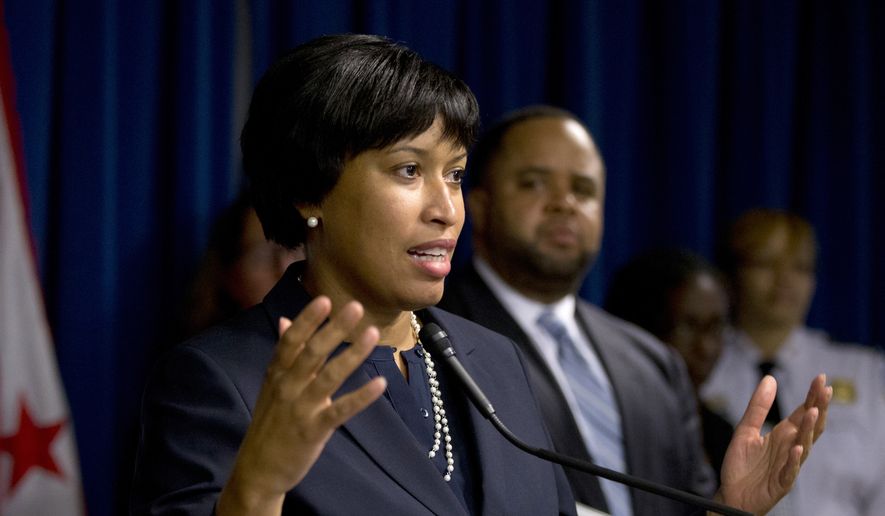D.C. Mayor Muriel Bowser on Tuesday outlined plans to close the homeless shelter at the former D.C. General Hospital and replace it with smaller facilities in every ward, receiving broad support from the D.C. Council even though one lawmaker said his ward has too many shelters.
At a breakfast meeting with council members and city officials, Ms. Bowser said her plan aims to provide a stable environment for homeless families while transitioning them to full-time housing.
Originally a temporary shelter, the 285-room D.C. General in Southeast eventually became the District’s main homeless shelter, housing as many as 288 families at a cost of about $17 million a year. The new citywide shelter plan calls for closing the derided former hospital and is estimated to cost $22 million per year.
D.C. Human Services Director Laura Zeilinger said each short-term family housing site will accommodate up to 50 families. Unlike D.C. General, she said, the facilities will have places for children to play and do homework, along with social services personnel to address residents’ needs and 24-hour security systems.
Each shelter will be built to fit the character of the neighborhood, Ms. Zeilinger said.
“We want beautiful facilities that fit in the block and blend in,” she said.
Council member Kenyan McDuffie, Ward 5 Democrat, took issue with plans for a homeless facility in his jurisdiction.
“The [citywide] strategy is right,” Mr. McDuffie said at the breakfast meeting, “but the Ward 5 location faces a host of challenges.”
The Ward 5 shelter would be at 2266 25th Place NE in the Langdon Park neighborhood. That is just around the corner from the Catholic Charities men’s shelter and a homeless day shelter on Adams Place, as well as the Days Inn on New York Avenue — one of several hotels in the city that host homeless families.
Mr. McDuffie said the area is oversaturated with shelters that the city would have to move to make way for the new location. Businesses and the community would be negatively affected by having four homeless shelters within a half-mile of one another, he said, and he isn’t sure he can support the plan if the proposed Ward 5 location does not change.
“Ward 5 bears the lion’s share,” he said. “Residents want the city to invest in that community, so I’m hopeful that the administration will work with the residents.”
When asked about Mr. McDuffie’s issues with the Ward 5 location, Ms. Bowser took umbrage.
“He didn’t suggest another location. I’ll tell you that,” she said.
City Administrator Rashad M. Young said Bowser administration officials had done everything they could to find appropriate locations in each ward.
“We searched wide and far in the wards,” Mr. Young said. “We hired a broker to scour what was available.”
Ward 2 is not included in the plan because a women’s shelter at 810 Fifth St. NW is set to open as low-barrier housing that will accommodate up to 213 women. That shelter will replace two facilities at Second and D streets Northwest.
According to the Metropolitan Washington Council of Governments’ most recent survey, there are 7,298 homeless people in the District — 6 percent less than in 2014 but 11 percent more than in 2011. Most homeless people are housed in emergency shelters, and more than 1,500 are in transitional housing facilities.
The District doesn’t count the number of shelters, but the beds provided for homeless people are identified as either family or single units. The city’s winter shelters provide 682 single beds and 405 family units with a total of 1,312 beds.Emergency shelters offer 2,256 single beds and 406 family units with a total of 1,295 beds. Transitional housing facilities have 950 single beds and 428 family units with a total of 1,190 beds.
Once the D.C. Council approves the overall plan to build shelters in each ward, permitting and development will start. The facilities will be open by the fall of 2018, at which time D.C. General will close permanently as a homeless shelter.
Council member Brianne Nadeau, Ward 1 Democrat, called D.C. General a “terrible place.” She said she has met with residents who are ready to welcome the families into their community. The Ward 1 site calls for 29 units of apartment-style housing.
“The new building in Ward 1 will be a safe and secure place where parents and children can live in dignified conditions while they work to find permanent housing,” Ms. Nadeau said.
Council member Mary M. Cheh, Ward 3 Democrat, said she spoke with a “small but representative group” this week and that her constituents are eager to embrace the new shelter.
“They feel a sense of obligation, and they want to help,” Ms. Cheh said. “This is as hopeful as I’ve ever been.”
Council member Yvette Alexander, Ward 7 Democrat, said community leaders were anticipating two or three shelters. “I’m grateful that each ward is bearing the responsibility,” she said.
• Ryan M. McDermott can be reached at rmcdermott@washingtontimes.com.




Please read our comment policy before commenting.